Pear trees can produce fruit naturally in fertile soil. The two main reasons for fertilizing them are encouraging growth and making healthy trees have more fruit. In addition, fertilizing the Pear tree will increase yield and resistance to pests and diseases. There is often the temptation to over-compost in the hope of producing even healthier, more prominent, or more productive trees. Let’s best fertilizers for Pear trees.
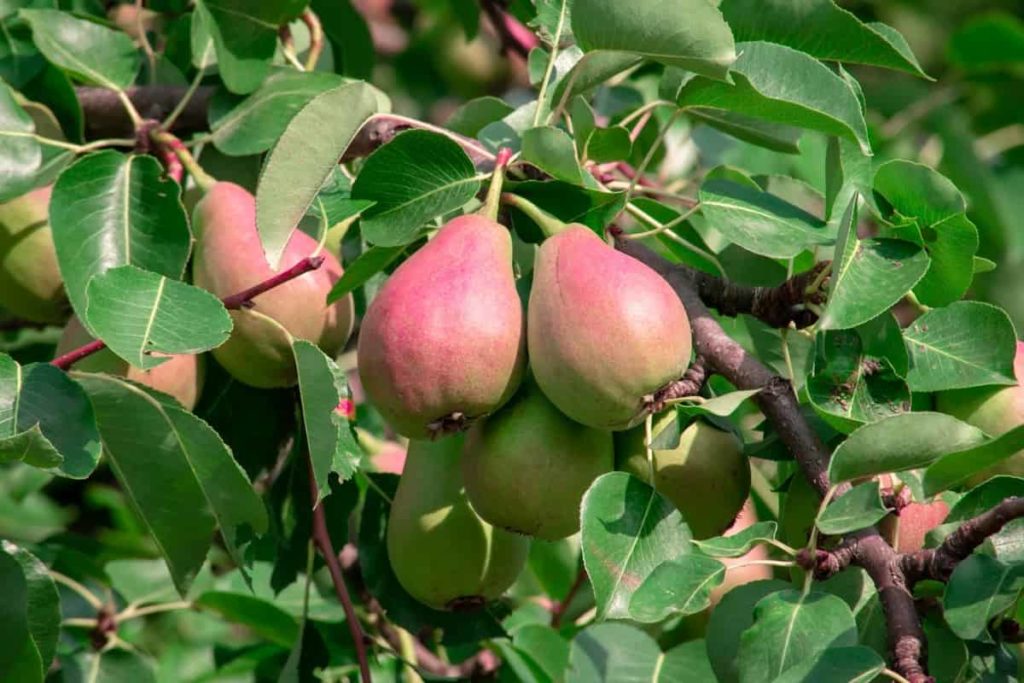
If you force the Pear tree much further than its natural growth rate through overfertilizing, you can cause it to grow very fast. It can result in structural problems, weaken trees become prone to pests or diseases, and reduce tolerance to droughts or temperature extremes. Do not fertilize a Pear tree in late summer or fall. If you do, the tree will likely produce much new growth, followed by a risk of damage caused by frost.
Check your soil to see if it meets the tree’s needs will tell you if your Pear tree needs fertilizer since Pears are like a little acidic soil. Pears have moderate fertility needs, so you probably don’t have to feed them if your tree looks healthy. Also, if you heavily pruned the Pear trees, do not give fertilizer. You can stop using fertilizers in nutritious soil until your Pear trees start bearing fruit. All fruit trees need nitrogen to boost growth and leaf production.
However, too much nitrogen promotes a lot of healthy leaves and low fruit. Also, Pears need several months before winter to harden off. The process is delayed if the nitrogen levels in Pears are high after midsummer. If the tree is in the lawn area, reduce the turf fertilizer so your Pears don’t get too much nitrogen. Pears also need potassium and phosphorus, which are can usually absorb enough amounts with their extensive root system.
Best fertilizers for Pear trees
Homemade fertilizers for Pear tree
Coffee grounds
Coffee grounds can add nitrogen and acidity to the tree soil. You can apply coffee grounds directly on top of the tree soil. If your soil already has a high quantity of nitrogen, an additional boost from coffee grounds can prevent fruit and flower growth.
In case you miss this: Pear Gardening For Beginners – How To Start, FAQs
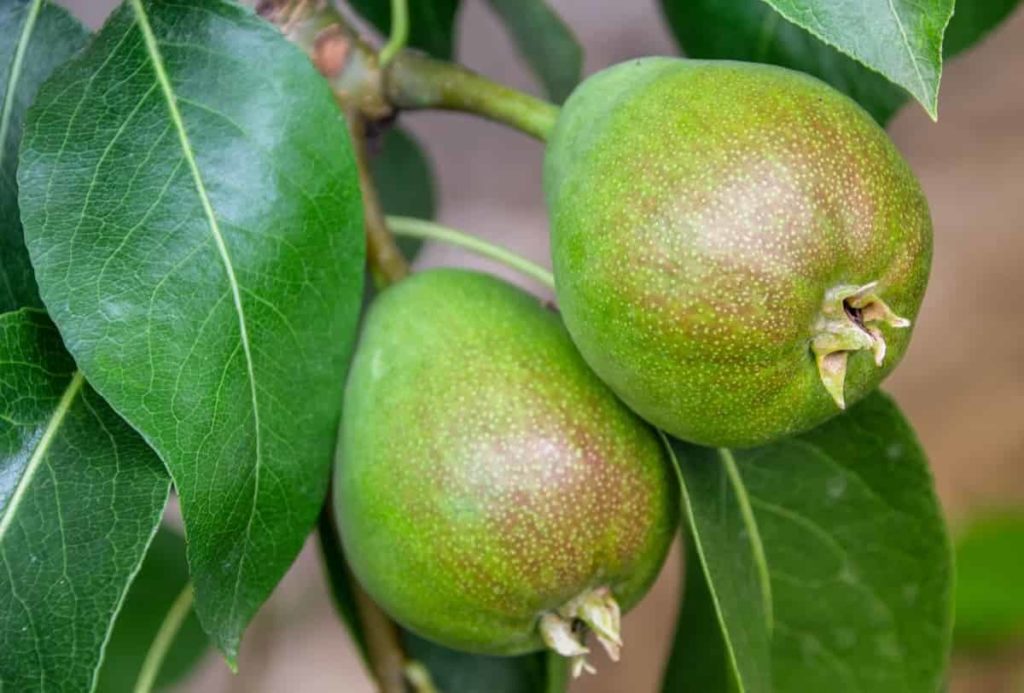
Wood ash
Pears trees thrive slightly from acid to neutral pH levels. Therefore, use little of the wood ash on these trees, if at all, unless the soil is highly acidic.
Organic fertilizers for Pear tree
Bone meal
Bone meal provides phosphorus to Pear trees. Phosphorus promotes early growth, root formation, and fruit growth. Other nitrogen fertilizers like blood, soybean, cottonseed, and feather meals excellent sources for Pear trees.
Cottonseed meal
Cottonseed meal has nitrogen, phosphorus, and potassium. Because of its nutrients, it can play as a perfect nitrogen fertilizer. In addition, cottonseed meal improves soil structure, helps in proper plant growth and health.
Natural fertilizers for Pear tree
- Mulch annually with either wood chips or partially composted sawdust. Placing any mulch material at least six inches away from the base of each Pear tree avoids trapping rot-causing moisture against the stem and other insects.
Liquid fertilizers for Pear tree
Compost tea
Regular watering of an inch of compost tea adds potassium and micronutrients to the soil.
Seaweed
Liquid seaweed extract is the best fertilizer for potted Pear trees.
Compost manure for Pear tree
Compost and well-composted manure increase phosphate and improve soil quality. To loosen the soil, mix the cow manure, compost into your pile of topsoil. You can use chicken manure pellets for Pear trees.
In case you miss this: Planting A Pear Tree – A Full Guide
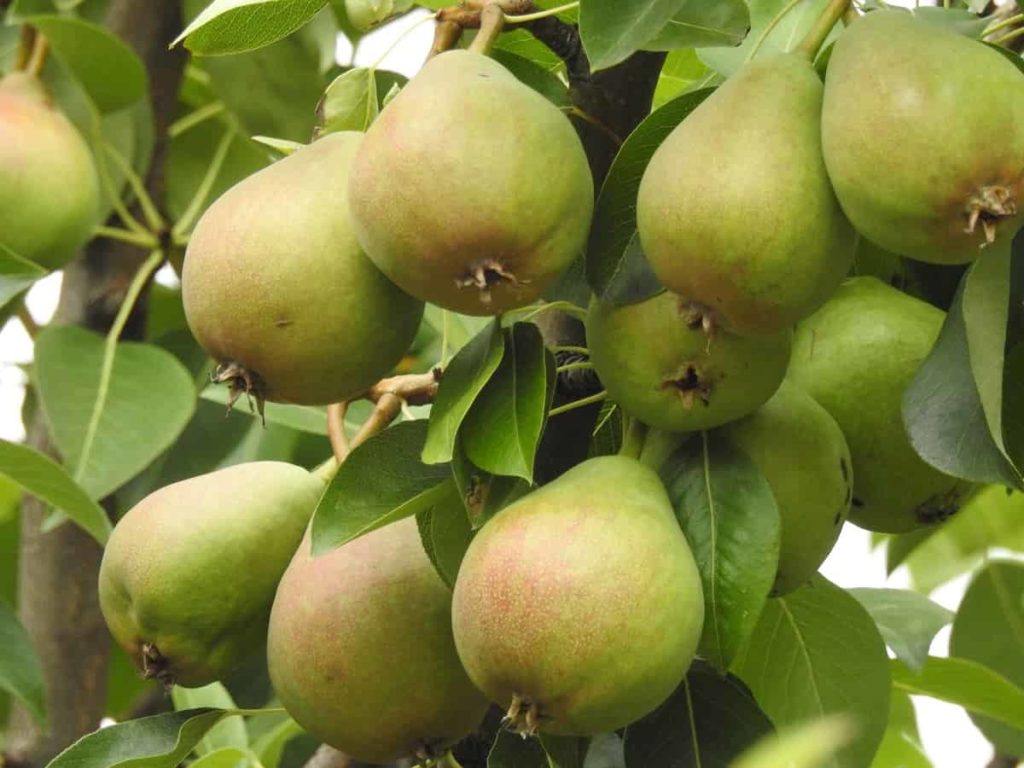
Vermicompost – Vermicompost treated plants produce healthy Pear fruits of better quality.
Commercial fertilizers for Pear tree
NPK ratio
Pear trees use nitrogen, an excess that promotes the rapid growth of branches and leaves at the expense of flowers and fruits. Phosphate deficiency is found in alkaline soil or organic matter deficient soil. Potassium is essential for apples and Pears to grow in large, flavored fruits. You can select balanced fertilizer 10-10-10 for Pear trees. The first number represents nitrogen; it gives plants the ability to produce more chlorophyll, resulting in faster leaf growth.
With every additional nitrogen application, plants should be tall and green. Fruit trees need nitrogen for shoot growth and leaf production, resulting in fruit intake and quality. Generally, fertilizers are high in nitrogen not recommended for use on Pear trees. Phosphorus helps develop roots and, therefore, can help increase bloom size and bloom production. Pear trees have a vast root system that can absorb enough potassium and phosphorus from natural supplies in the soil. It is being said that if your trees are not flowering and taking fruit well.
In case you miss this: Best Fertilizer for Cantaloupe/Muskmelon – Homemade, Organic, Liquid, NPK, Compost, How and When to Apply
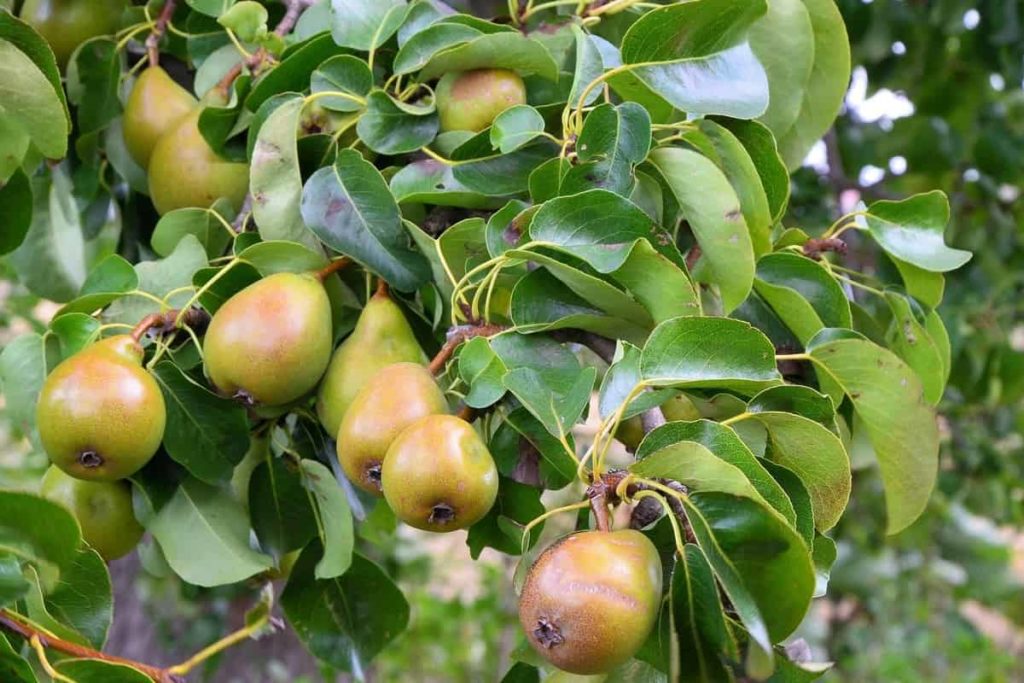
Soil testing indicates phosphorus deficiency; you will need to apply additional phosphorus to enhance bloom and increase fruit production. Potassium protects the plant against diseases and aid in drought protection and cold tolerance. It also plays a role in improving the development of roots and helps in the process of photosynthesis. Suppose your Pear trees are not flowering and the fruits are not growing well, and soil testing indicates potassium deficiency; In that case, you will need to apply an additional amount of potassium to bloom and boost fruit production.
Pear tree fertilizer schedule
In general, you should apply fertilizer after giving water. It prevents fertilizer from burning the delicate roots of the tree below the soil surface. When using commercial fertilizers, fertilize Pear trees in spring and immediately after harvesting for the second time in the fall. You can use compost at any time during the growing season, and you should regularly apply compost tea as a part of the water. The easiest way to fertilize Pear trees is to use a balanced 10-10-10 fertilizer.
Spread 1/2 cup of fertilizer in a circle that is 6 inches from the stem and ends at a distance of two feet from the Pear tree. You want to keep fertilizer away from the trunk to prevent burning. Make the fertilizer work lightly in the ground for about 1/2 inches, and then water it well. Feed young trees monthly with just a quarter cup during the growing season. Mature trees should be fed with 1/2 cup for each year of age every spring until the Pear turns four, and then use 2 cups permanently.
In case you miss this: Guide to Growing Red Banana in Home Garden: Planting and Care.
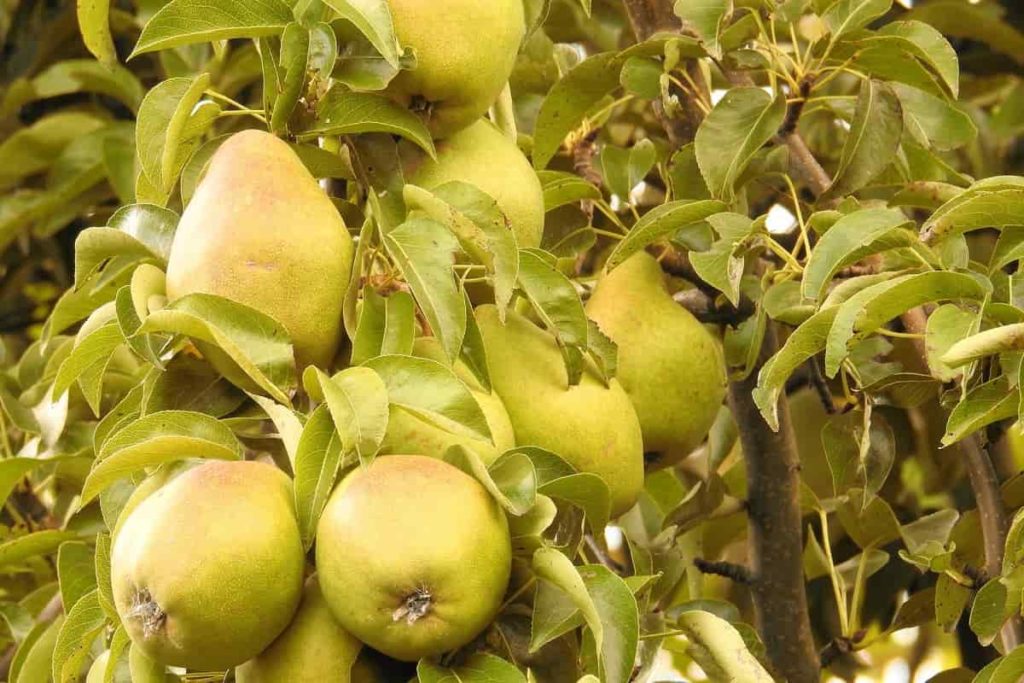
Keep the area around young trees weed-free and water-free. Fertilize them two weeks before their second year and subsequent blooming in spring. You can also use ammonium nitrate as fertilizer for Pear trees. Use 56 grams multiplied by the age of the Pear tree. Useless if you already have very fertile soil. Next year, add a little more fertilizer if the leaves turn yellow-green to yellow in the middle of summer.
Other fertilizer options should be applied at 45 grams per inch of trunk diameter, measured one foot above the ground. Some include ammonium sulfate, ammonium nitrate, and blood or cottonseed meal.
How to fertilize the Pear tree in the pot
If you grow the Pear tree in highly fertile soil, use less fertilizer. Fertilizer seating should start when new growth begins in spring. Use complete fertilizer that reduces nitrogen content compared to phosphorus and potassium. Over nitrogen often produces leafy branches and prevents growth. Keep newly planted Pears in water when establishing them, and treat them once a year with organic matter such as compost, well-rotten manure.
Boost them with chicken manure pellets every few years; sometimes, liquid seaweed feed also makes a good tonic. For Pears in containers, remove 2 inches over the potting mix every year and replace it with a fresh potting mix equipped with balanced organic fertilizer. When the tree is 12 inches high in one season, use less manure next year. If the address appears yellow in summer, use a little more fertilizer next year.
Top 20 Steps To Boost Your Apple Fruit Yield: Fruit Size Increase Tips and Ideas
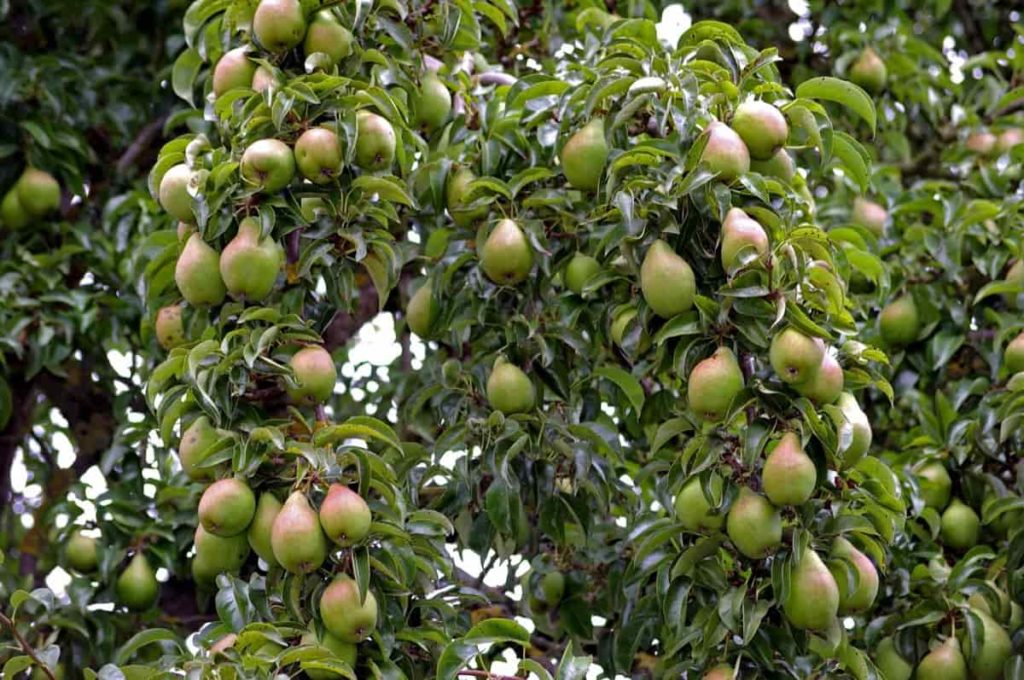
Frequently asked questions about fertilizers for Pear tree (FAQ)
Why are my Pear tree leaves are turning yellow?
Your tree may lack iron if your new leaves are yellow to white with green veins. The lack of nitrogen brings small fresh leaves and fallen mature yellow leaves.
Why was my Pear tree no longer a flower?
Dehydration can also cause a mature Pear tree to fail to bloom. Providing deep water every week during the growing season can go a long way toward the Pear tree blooming. Finally, improper pruning or extra fertilizing can be why the Pear tree did not bloom.
Why is my Pear tree not growing?
If the Pear tree is weak, stressed, or diseased, it will produce very little or poor-quality fruit. If there is no fruit in the Pear tree, it could also be because it did not find the necessary amount of cold weather to break dormancy and encourage new growth.
How do I grow big Pears?
Grow Pears in a partial shade in moist but well-drained soil throughout the sun. Mulch with well-rotten manure or compost annually.
- Gardening Techniques in Planting Vegetables
- Where to Place Indoor Plants in Your Home
- How to Grow Tomatoes Organically at Home: A Comprehensive Guide
- Organic Gardening on a Budget: Low-Cost Methods and Materials
- Gongura Seed Germination and Planting Methods
- Cabbage Seed Germination and Selection
- Broccoli Seed Germination and Selection
- Asparagus Seed Germination and Variety Selection
- Seasonal Flower Gardening: Best Practices for Spring, Summer, Fall, and Winter
- How to Grow Hibiscus from Flower
- Plantation Ideas for Home Decoration: A Beginners Guide
- Flower Garden Designs and Layouts for Beginners
- Planting and Spacing Techniques in Papaya: A Beginner’s Guide
- Growing Gold: Essential Techniques for Planting Pineapples
- How to Make Kalanchoe Plant Bushy: Home Remedies and Solutions
- 11 Reasons Why Your Gardenia is Not Blooming: Home Remedies and Solutions
- Eco Elegance: The Guide to Designing a Drought-Tolerant Landscape
- Gardening on a Slope: Strategies for Hillside Landscaping
- Nourish and Flourish: Top Organic Mulches for Thriving House Plants
- Everything You Want to Know about Indian Mogra Flower: Discover Uses and Growing
- Green Thumb Success: Expert Tips for Cultivating Greenhouse Pumpkins All Year Round
- Maximize Growth & Flavor: The Ultimate Guide to Companion Planting in Herb Gardens
- How to Control Rhododendron Problems Naturally: Home Remedies and Organic Ways to Fix Them
- Natural Magic: The Remarkable Benefits of Cinnamon for Plants
- Best Steps to Revive Dying Tulip with Natural and Organic Treatment
- 10 Reasons Why Your Angel Trumpet is Not Blooming: Remedies and Treatment
- How to Fix Periwinkle Leaf and Flower-Related Problems: Natural Remedies and Solutions
- How to Fix Zinnias Leaf and Flower Problems: Discover Natural and Home Remedies
- Organic Steps to Induce Lemon Tree Flowers: A Comprehensive Guide
- Bloom Booster: Crafting the Perfect Homemade Bougainvillea Fertilizer
- Optimizing Growth: A Guide to Applying NPK Fertilizer for Potted Plants
- 10 Best Homemade Fertilizers for Rubber Plant: DIY Recipes and Application Method
- How to Boost Female Pumpkin Flowers: Effective Steps for More Flowers and High Yields
- Transform Your Indoor Garden: Top Benefits of Pink Salt for Houseplants
- 10 Best Homemade Fertilizers for Peacock Plants (Calathea): Easy DIY Guide
- Unlock Blooms: 9 Reasons Why Your Potted Chrysanthemum is Not Blooming